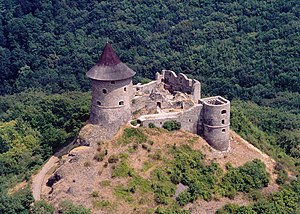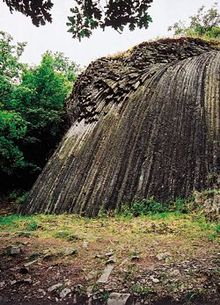Šomoška Castle
| Šomoška Castle | ||
|---|---|---|
|
Aerial view of the Šomoška Castle |
||
| Creation time : | Late 13th century | |
| Castle type : | Hilltop castle | |
| Conservation status: | partially rebuilt | |
| Place: | Šiatorská Bukovinka / Somoskő | |
| Geographical location | 48 ° 10 '17 " N , 19 ° 51' 25" E | |
|
|
||
The Šomoška Castle ( Slovakian Hrad Šomoška , Hungarian Somoskői vár ) is the ruin of a hilltop castle in southern Slovakia , right on the Slovakian-Hungarian border . The castle bears the name of the Hungarian town of Somoskő at the foot of the castle hill (part of the town of Salgótarján ), but it is located a few meters across the border on the Slovak side. It is located in the Cerová vrchovina mountain range on a basalt hill, about 40 minutes' walk east of the village of Šiatorská Bukovinka in the Okres Lučenec . The castle hill with the so-called "stone waterfall", which consists of hexagonal basalt columns , is a subject of nature conservation.
Building history
The original castle was composed of a small triangular forecourt enclosed by the ramparts and the adjoining castle palace itself and a few farm buildings. When cannons began to spread in the 15th century , this facility was expanded to include the southern horseshoe-shaped bastion , the western cylindrical bastion and the barbican to the north . During the uprisings of the 17th century, the living quarters were enlarged and the double walls at the gate added. The last addition was probably the polygonal cannon bastion protruding to the northeast. The building material used is always the local basalt , a specialty in Slovakia.
history
The castle was built at the end of the 13th century as one of several new fortifications of the Kingdom of Hungary after the devastating Mongol invasion in 1241. The castle was probably built on the orders of a certain Illés (some sources give the year 1291) from the Kacsics family, the also built other castles in Nógrád County . Just a few years after the building, the owners joined the oligarch Matthäus Csák , who fought against the Hungarian kings (→ Hungarian small kingdoms ). Eventually the oligarchs used the castle to launch attacks on royal supporters. After the consolidation of the central power under Charles I , the king took the property from the Kacsics family in 1323 and assigned it to the loyal follower Tamás Szécsényi. In the same year the castle is recorded as castrum Somoskw .
At that time, the castle was one of the centers of regional social life, but the dynasty got deeply in debt, so that in 1455 Ladislaus Szécsényi had to pledge the castle to the land manager Mihály Országh and in 1461 to the husband of his daughter Hedviga, Albert Lossonczy. In the same year the Szécsényi family died out and in 1481 the castle came to the aforementioned Lossonczy family.
After the capital Buda was conquered by the Ottoman Empire in 1541, the danger of Turkish attacks increased significantly. The last male member of the Lossonczy family, István, was captured during the defense of Timisoara in 1552 and executed shortly afterwards. According to István's request, his daughter Anna inherited the castle. In 1554, however, the Turks conquered the nearby castles of Fülek and Salgó , thus including Somoskő Castle with its location in Turkish territory. Despite several attacks, the castle was not taken over the next 22 years, and the crew, made up of 50 foot soldiers, 40 hussars and 10 gunners, was even able to disrupt the connection with Fülek Castle (then the seat of a sandschak ). In 1576 an army under the Bey von Fülek conquered the castle almost without a fight; the crew fled to Eger . In 1593 the castle was taken by a Hungarian army without a fight after the Turks were defeated at Fülek Castle. Shortly afterwards the owner Anna died and the castle came into the possession of the Forgách family.
Despite the liberation from the Turks, peace was still a long way off. In 1605 the anti-Habsburg rebels took the castle from Stephan Bocskay , but in 1606 it returned to the king after the Peace of Vienna . The same thing happened in 1619 with the occupation by Gabriel Bethlen's troops; this was reversed by the Peace of Nikolsburg . Because of its importance as a bailey for Fülek Castle, the state parliament ordered the restoration and strengthening of the damaged castle in 1608, 1618–19 and 1648; a double wall at the Gothic gate and a cannon bastion were built. Despite these construction measures, the fighting ability was limited by lack of water. In 1703 the occupation surrendered to the rebels of Franz II Rákóczi ; after the suppression of the uprising, the Forgách family lost the castle in 1709. By decree of the king the castle was to be demolished; The tenant Ráday only had parts of the roof burned.
In 1826 the castle burned down after a lightning strike; since then it has been essentially just a source of building materials for local residents. According to the Treaty of Trianon , the castle came to Czechoslovakia , but the area remained controversial with the communities of Somoskő and Somoskőújfalu . In 1924 the two places came back to Hungary, but the castle with its basalt quarry remained with Czechoslovakia (or today Slovakia). Only in the years 1938–45 did the castle briefly belong to Hungary again after the First Vienna Arbitration . The castle complex was only partially renovated in the 1970s.
Unusual basalt structures
Basalt columns made from lava on the castle hill are shaped like a waterfall.
Individual evidence
- ^ National nature reserve Šomoška , accessed April 10, 2012
- ↑ Šomoška Castle ( Memento of the original from May 8, 2012 in the Internet Archive ) Info: The archive link was automatically inserted and has not yet been checked. Please check the original and archive link according to the instructions and then remove this notice. on slovakia.travel, accessed April 10, 2012
- ↑ História: Keď mala ČSR or dve obce viac ( page no longer available , search in web archives ) Info: The link was automatically marked as defective. Please check the link according to the instructions and then remove this notice. , lconline.sk (Slovak), accessed April 10, 2012





